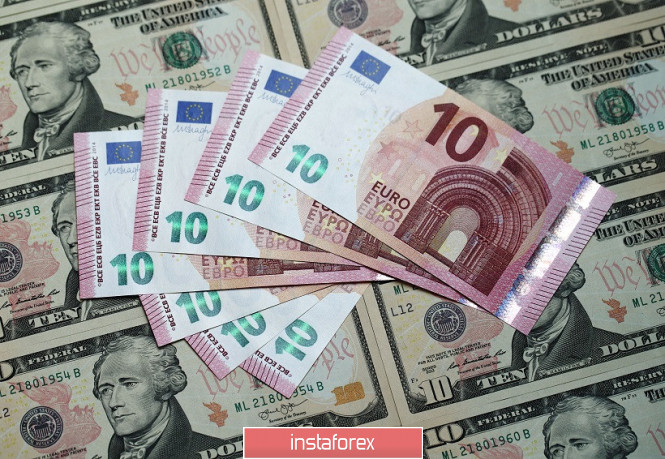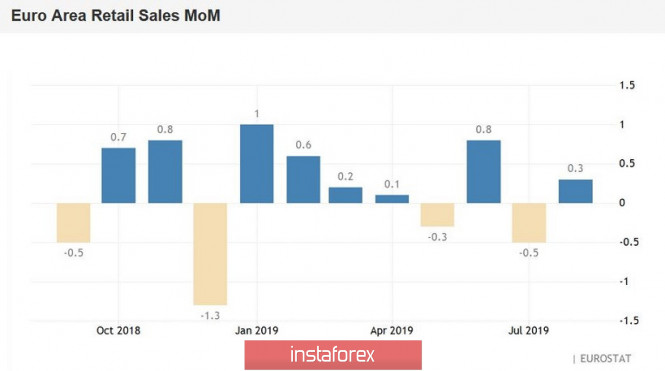The European currency actually ignored the news that the European Union lost a subsidy dispute for Airbus to the World Trade Organization, although this fact signals a new trade confrontation - between the United States and the European Union. Washington has already expressed its readiness to introduce tariffs authorized by the WTO ($7.5 billion), while Brussels has expressed similar willingness to use mirror measures.
The WTO decision was announced last night, but this morning it became known that the White House will exercise its right and from October 18 will introduce additional tariffs on the above amount for certain goods imported from the European Union. The list of these products is quite large - in particular, civil planes will impose a 10 percent tariff, and food and alcoholic beverages (Scotch whiskey, French wine, sire, clothing, coffee) will be charged at a 25 percent tariff. In addition, European pork, yoghurts, butter, olives and other European exports most in demand in the United States will fall under new sanctions.

It is worth noting that traders in the foreign exchange market (primarily the euro) reacted fairly calmly to these events, as they were widely expected. Washington voiced its claims back in April this year: according to the White House, three EU countries (namely France, Italy, Spain and Germany) illegally subsidized the European aircraft manufacturing concern Airbus, causing the US state $7 billion in annual damage.
Trade negotiations on this issue were postponed for a long time, since Brussels could not agree on the candidacy of a negotiator. After numerous disputes, which lasted many months, representatives of the EU countries agreed to give a mandate for negotiations to the European Commissioner for Trade Cecilia Malmstrom. But in the end, the dialogue with Washington never began - neither in the beginning of summer, nor in the beginning of September. The US waited for the final decision of the WTO, after which they announced the introduction of new barriers. According to many analysts, Trump with the EU will follow the same strategy as with China - first he will introduce duties, and then he will sit at the negotiating table. There is another scenario. It is expected that in a few months the WTO will allow the European Union to introduce countermeasures against the United States as part of a parallel (and essentially similar) Boeing case due to the company's non-compliance with the organization's rules. In this period of time, the European Union will again try to resolve this issue peacefully.
Considering these factors, the EUR/USD pair showed only a formal reaction to the Brussels loss in the WTO - the price dropped to the bottom of the 9th figure, but returned to its previous position today. This does not mean the strength of the European currency, but rather the vulnerability of the dollar. The possible consequences of the situation around Airbus and Boeing have been discussed by the market for a long time, but negative macroeconomic releases from the US were an unpleasant surprise for dollar bulls. Therefore, after a short pause, the pair continued corrective growth.
It is obvious that the market is waiting for the main macroeconomic report of the week, which will be published on Friday. Yesterday there was another "wake-up call" in the form of a weak report from the ADP agency, which is a kind of storm petrel ahead of Nonfarms. If the official figures repeat the trajectory of the data from ADP, the dollar will again fall under the wave of sales - after all, in this case, rumors about another round of monetary policy easing by the end of this year will intensify in the market. By the way, tomorrow, Federal Reserve Chief Jerome Powell will speak at the close of the trading week. He will take part in the Fed hearings, which will be devoted to the problems of population employment and price stability. His speech is scheduled for 18:00 (London time), that is, after the publication of key data on the US labor market. Therefore, he will probably comment on the dynamics of Nonfarm in the context of the prospects of monetary policy. It is worth noting that the reaction to his speech may be stronger than the release itself. Given this assumption, do not rush to trading decisions immediately after the publication of US data.
But the European currency received a temporary respite. Negotiations on Brexit are moving forward (according to the latest rumors, the Conservative Party and the DUP have supported Boris Johnson's new proposals), and September inflation in the eurozone as a whole turned out to be at the forecast level. In addition, very good data on retail sales in the eurozone provided additional support for the single currency. There can be no talk of a trend reversal - the EUR/USD bears still control the situation. But amid the general vulnerability of the dollar, the European currency was able to afford a tangible correction.

The "ceiling" of the correction is currently at the 1.1000 round mark - at this price point, the middle line of the Bollinger Bands indicator on the daily chart coincides with the Kijun-sen line. If the pair overcomes this resistance level, then the EUR/USD bulls will open the way to the next price barrier - to 1.1090 (where the upper line of the Bollinger Bands indicator coincides with the lower border of the Kumo cloud on the same timeframe). If tomorrow's events are in favor of the dollar, then the pair will return to the bottom of the 9th figure, and the bears will make another attempt to test weekly lows (1.0880 area).
The material has been provided by InstaForex Company - www.instaforex.com